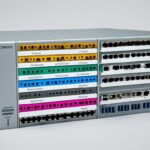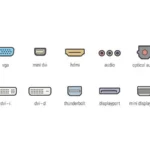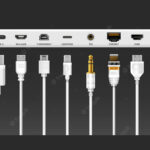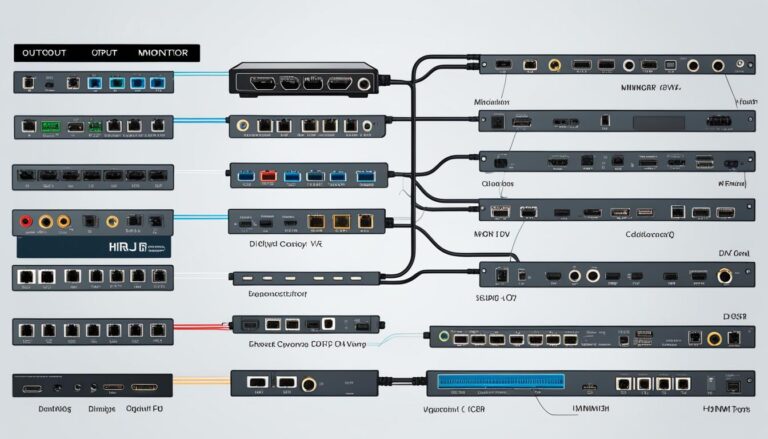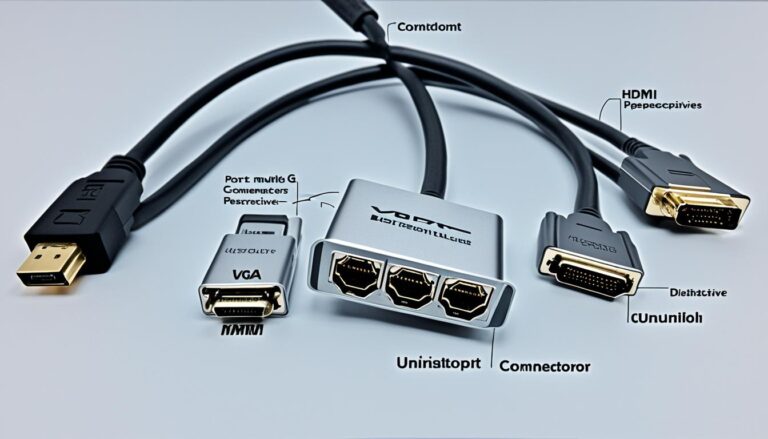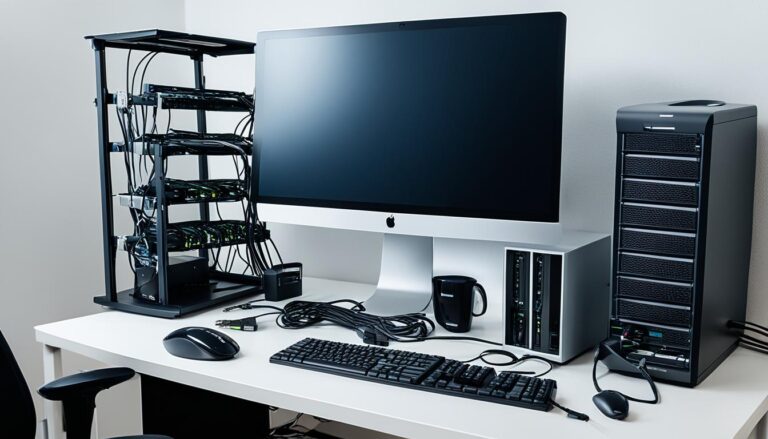TVs have many ports on the back for connecting devices. These ports are for different uses and signals, like digital or analog. You often see HDMI, DisplayPort, VGA, DVI, and USB-C ports on TVs. Each type offers its own positives and works with various devices. Knowing about these helps you find the right port for your needs.
HDMI – The Most Common Port for TV Connectivity
HDMI (High-Definition Media Input) is a versatile port used widely for connecting TVs. It forms an essential bridge for devices, enabling smooth audio and video flow. Through HDMI, connecting various gadgets like game consoles, media players, and computers to your TV is easy.
HDMI shines by transporting data digitally, offering top-notch picture and sound. This method keeps the quality of audio-visuals high, enhancing your viewing. Moreover, HDMI caters to high-definition formats like 4K Ultra HD. This makes it perfect for the latest gadgets.
Using HDMI brings several practical perks. A single cable can link many devices, cutting down on mess and making your space neater. HDMI cables fit many devices and are easy to find. Plus, they support audio return channels, so your TV can send sound back to your sound system without extra wires.
Advantages of HDMI for TV Connectivity:
- HDMI enables the transmission of both audio and video signals.
- It ensures high-quality, crystal-clear picture and sound.
- HDMI supports high-resolution formats like 4K Ultra HD.
- It simplifies the setup with a single cable connection.
- HDMI cables are widely available and compatible.
- It supports audio return channels for streamlined audio transmission.
HDMI is the go-to choice for TV connectivity due to its versatility, exceptional signal quality, and ease of use. Whether you want to enjoy gaming, streaming, or multimedia content, HDMI provides a reliable and convenient solution for connecting your devices to your TV.
With HDMI as the foundation of your TV setup, you can explore vast entertainment options. Dive into breathtaking visuals and rich sound. Let HDMI transform your TV watching into an extraordinary experience.
Other Common Video Ports on TVs
HDMI is the top choice for TV video ports. But, you’ll find other kinds too during your TV journey. Knowing these can help you connect devices to your TV smarter.
Component Video Ports
Component video ports work well with DVRs, media players, and old game consoles. They provide high-quality analog video, meaning the picture looks great. These ports have three cables, coloured red, blue, and green, for video. Red and white cables are for audio. Use component video ports for non-HDMI devices or if you prefer analog connections.
S-video Ports
S-video ports used to be more common but are still on some TVs and PCs. They offer better video than composite ports but aren’t as good as HDMI or component. S-video improves image sharpness by separating brightness and color signals. If your older devices have S-video, you might need adapters to connect to new TVs.
Composite Video Port
Composite video ports are known for their yellow connectors. They’re used for standard-definition video and have red and white audio connectors. These ports were common but are less so as devices shift to digital. You might see them on older consoles, VCRs, or DVD players.
Learning about these video ports helps you choose the right one for your TV connections. Your choice depends on what devices you have and your needs. Each port offers different video and audio quality, so think about device compatibility and quality when connecting.
Audio Ports for TV Connectivity
Audio ports are key when linking your TV to external sound systems. They make sure the connection is smooth and the sound is better. You’ll find optical digital, coaxial digital, and RCA stereo ports on most TVs.
Optical Digital Ports
Optical digital ports are a top choice for sending audio. They use a digital format for clear sounds. You’ll see them on soundbars and A/V receivers a lot. They’re great for setups that can use this connection.
Coaxial Digital Ports
Coaxial digital ports are another way to send digital audio. They’re reliable and work well with many devices. Use them with sound systems, amplifiers, and home theaters. They offer a steady connection and top-notch sound quality.
RCA Stereo Ports
RCA stereo ports have red and white plugs. These analog ports are near the video ports on TVs. They work with DVRs, media players, consoles, and soundbars. They’re great for older devices not fit for digital audio.
With these ports, connecting your TV to external speakers is easy. Optical digital, coaxial digital, or RCA stereo ports each have their perks. Think about what your setup needs. Then, pick the right port for the best TV sound.
Computer Connectivity with TVs
Modern TVs do more than just show broadcasts and stream shows. They can act as big computer screens. This lets you work better or have more fun gaming. Connecting a PC to a TV is simple. The type of connection depends on your devices’ compatibility.
We’ll look at common ports for linking computers to TVs. These include DVI, VGA, USB, and DisplayPort.
DVI (Digital Visual Interface) is often used for PC to TV connections. It sends high-quality video and gives clear images. DVI lets you watch high-def content with great picture quality. Many TVs have DVI, making it easy to use.
For VGA (Video Graphics Array), it’s an option if your gear is older. VGA is an older kind of tech that sends analog video. It’s not as sharp as digital, but it’s okay for simple use or old gear.
USB (Universal Serial Bus) ports are super flexible. With USB, you can link external drives, like hard drives. Plus, some TVs let you use USB-to-HDMI adapters. This means you can connect your PC via USB to watch content on a big screen.
The DisplayPort is a top-notch choice. It mixes audio and video into one signal. It supports high resolutions and fast refresh rates. With DisplayPort, gaming looks silky smooth. And pros get the clear visuals they need.
To pick the best port, think about what your devices can do. Whether you need crisp video, simple analog, or easy USB, there’s a port for you.
Benefits of Connecting a Computer to a TV
- Increased screen size for improved productivity
- Enhanced gaming experience with a larger display
- Ability to enjoy multimedia content on a bigger screen
- Convenient access to computer files and media through USB connectivity
- Higher resolutions and refresh rates for optimal visual performance
By using the different ports available, you can make your TV a multi-use monitor. This improves your digital life.
Conclusion
TVs come with many ports for connecting different devices. HDMI is the most used because it handles video and audio. But, TVs also have other ports like component, S-video, and composite for certain needs. Plus, there are audio ports like optical digital, coaxial digital, and RCA stereo for outer sound systems.
Connecting a computer to a TV offers various options. These include DVI, VGA, USB, and DisplayPort. The best port to use depends on your devices and what quality you want. Knowing what each port does is key to the best connection and great watching experience.
To use your TV’s connections well, think about what you’ll connect and what you need it for. Pick the right display ports for a top-notch audiovisual experience or connecting a computer for work or fun. With the right knowledge and choices, you can make the most of your TV and devices together.
FAQ
What is HDMI and why is it the most common port found on TVs?
HDMI stands for High-Definition Media Input. It’s a versatile port for video and audio signals. It’s common on TVs for supporting high-resolution formats like 4K Ultra HD. This ensures a high-quality picture and sound. HDMI works with devices like game consoles, computers, and streaming gadgets.
What are the other video ports commonly found on TVs?
TVs also have component, S-video, and composite video ports. The component ports offer high-quality analog video. They work with DVRs and older game consoles. S-video ports are rarer but still exist on some TVs and computers. Composite ports handle standard-definition video.
What audio ports are available on TVs for connecting external sound systems?
Common audio ports include optical digital, coaxial digital, and RCA stereo. Optical digital transmits audio digitally, good for soundbars and A/V receivers. Coaxial digital is another digital audio option. RCA stereo ports send analog audio signals. You’ll find them with various devices like DVRs and soundbars.
How can I connect my computer to a TV?
You can connect your computer to a TV using ports like DVI, VGA, USB, and DisplayPort. DVI is for high-quality video signals. VGA is older, for analog video. USB allows easy connection of devices. DisplayPort sends high-resolution audio and video, supporting up to 144Hz at 4K.





